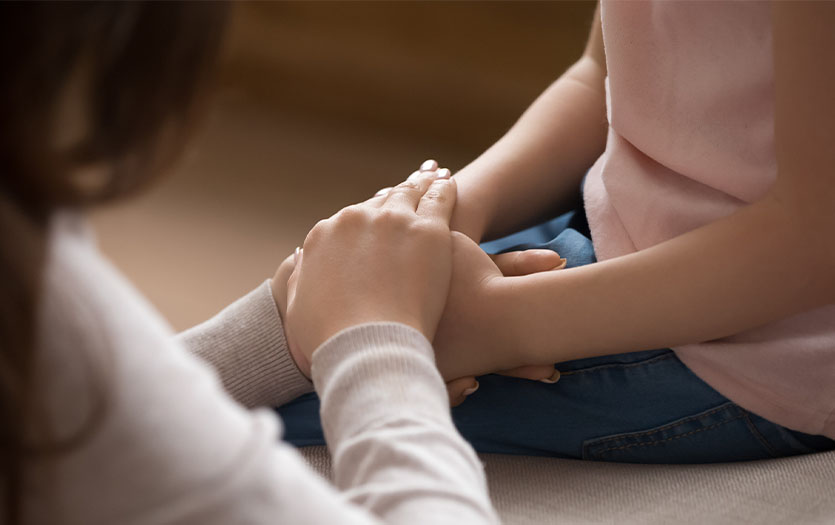
The marks that child neglect and harm leave behind go beyond what’s visible. In observance of National Child Abuse Awareness Month, we spoke with Tony GiaQuinta, MD, PPG – Pediatrics, about Parkview’s new child maltreatment clinic, designed to offer a more consistent approach, from assessment to services.
How prevalent is child abuse and neglect in Indiana?
The data tells us that:
- 1 in 5 children are sexually molested
- 1 in 4 children are beaten by a parent to the point of leaving a mark
- 1 in 3 couples engage in physical violence
- 1 in 4 children grew up with alcoholic relatives
Child abuse and neglect is very insidious because of the quiet nature of it. Often bruises are hidden behind clothing, and the harms of neglect go unnoticed for years and sometimes a lifetime because emotional defense mechanisms children build to protect themselves from emotional, mental or physical injuries they’ve sustained.
What are some of the risk factors that can contribute to instances of abuse?
We know that child abuse and neglect have a generational pattern. Children who experience trauma are less likely to have the skills that help foster healthy parenting relationships when they grow up and have their own children. When that's combined with the toxic stressors that some parents experience every day – hunger, finances, managing a home, and the resources necessary to keep a child healthy and well provided for – it just adds to the powder keg that can trigger abuse or trauma.
What can you share about the new clinic aimed at improving the care journey for children of abuse or neglect?
We established a child maltreatment clinic for several reasons. The first priority is to provide a thorough assessment and diagnosis of any emotional or physical abuse a child has or is experiencing.
I am currently seeing patients in my pediatric office on Carew St., though the goal is to eventually partner with Trauma Services to move into a new space. The nice thing about our office is that it offers a safe, secure, developmentally friendly environment. As we consider moving the clinic, we will work with child life specialists to ensure the space feels warm and comfortable for the kids and has all the resources to perform our full assessments.
Our ERs are incredible for emergent events, but they are loud and busy. In the clinic, we take our time and do a full physical, dental and developmental evaluation. Historically, we’ve uncovered indicators of abuse through routine evaluations for a separate issue, like noticing bruising where it shouldn’t be while listening to a child’s lungs for a respiratory infection. That still happens, but when we’re able to see children in the clinic, we have the time to get an accurate history, perform a careful, sensitive evaluation with a critical eye, order any additional imaging or diagnostics tests and then facilitate a proper plan for best outcomes.
We know that no one intends to harm a child. These events are often spontaneous or impulsive, or due to poor coping mechanisms for a variety of reasons. When a child sustains an injury, afterward, parents want the child to receive a medical evaluation, though the story might be distorted to protect those involved. As medical providers, we understand what’s normal and abnormal in relation to development, and that expertise is invaluable in these situations.
If we confirm that an injury or neglect occurred, we then report that to the appropriate social services agencies so that everyone is clear on what needs to be put into place to create a halo of protection around the child. That preventative piece is big. We really want to arm that child with as many protective elements as we can. This could mean coordinating with community partners, like Stop Child Abuse and Neglect (SCAN), or connecting the family to the Indiana Department of Child Services (DCS) program, Family Preservation Services, aimed at keeping families together and providing parent-child interactive therapy and parenting skills. Sometimes a caregiver needs to better understand the nurturing needs of a child to reduce the likelihood of a traumatic event reoccurring. It could also mean helping a family find resources to secure food, housing or basic medical or dental needs. Often, children of abuse and neglect have fallen through the cracks from a health perspective, and we get them back on track.
Secondly, one of the biggest frustrations related to child abuse and neglect is that sometimes providers catch it but don’t feel like there’s a proper hand off or next steps to protect the child. The goal is to understand the abuse and then help put that child back together again.
Our first reporters are often the school systems, friends and family members who report to the DCS and the Emergency Room (ER). In these scenarios, there is often an initial evaluation and services might be put into place, but it doesn’t capture the follow up and long-term needs of the child. We want to ensure that all the details pertaining to that patient get communicated back to their medical “home” (their pediatrician or primary care provider, parents, school, etc., so that everybody who needs to understand what happened and what's needed to prevent this abuse from reoccurring.
Who can report to the clinic?
The model for the maltreatment clinic is designed around referrals from professional agencies, rather than the general public. What we noticed was that children would show up in the ER with repeated injuries and be sent home with a referral to DCS, but without a handoff to their medical home to ensure that follow up and resources were secured.
These cases often come in at odd hours, so we have a 24/7 referral system which makes it simple for an ER provider to refer a suspected case of neglect to the clinic right away and the child can be seen for follow-up within a week.
This is also helpful for DCS. While they will still direct patients to the ER to be evaluated if the situation is urgent, the clinic allows them to schedule appointments with skilled physicians who can perform thorough evaluations as an alternative option.
What are some signs of child abuse and neglect?
The signs of abuse can range quite a bit, depending on age and circumstances, but generally, there are two things caregivers can remember if they are suspicious:
- TEN-4 stands for bruising on the torso, ears or neck in children 4 or younger. Marks in these areas in young children can be an indicator of abuse.
- Kids that don't cruise, don't bruise. If a child is not walking, standing or moving around, they shouldn’t have bruises present. If we see marks on a child who is not mobile, that requires a story that makes developmental sense. Otherwise, we would rule that injury nonaccidental.
Do you have any guidance for how to navigate these sensitive situations with children and families?
In scenarios where we see an injury consistent with nonaccidental trauma, I am upfront with parents that the child has been harmed and that injury does appear to be accidental and then I reassure them that the injuries will heal and we will do everything we can to ensure the child is safe, with a plan to prevent future trauma.
What we do know about children, is that they have a lot of resiliency mechanisms, and that any injury will heal with time, in a safe environment with supportive adults. These are messages that any care provider can give to reassure a parent that their child’s future is protected.
If you suspect a child is being abused or neglected, Indiana state law requires you to report it. Call the Indiana Child Abuse and Neglect Hotline at 1-800-800-5556 24/7. DCS will conduct an evaluation and decide if a clinic assessment is needed.



